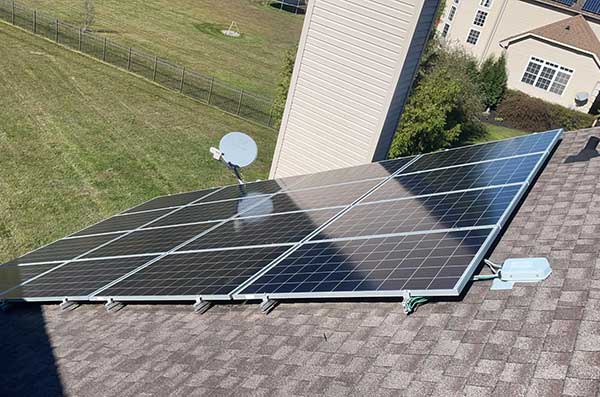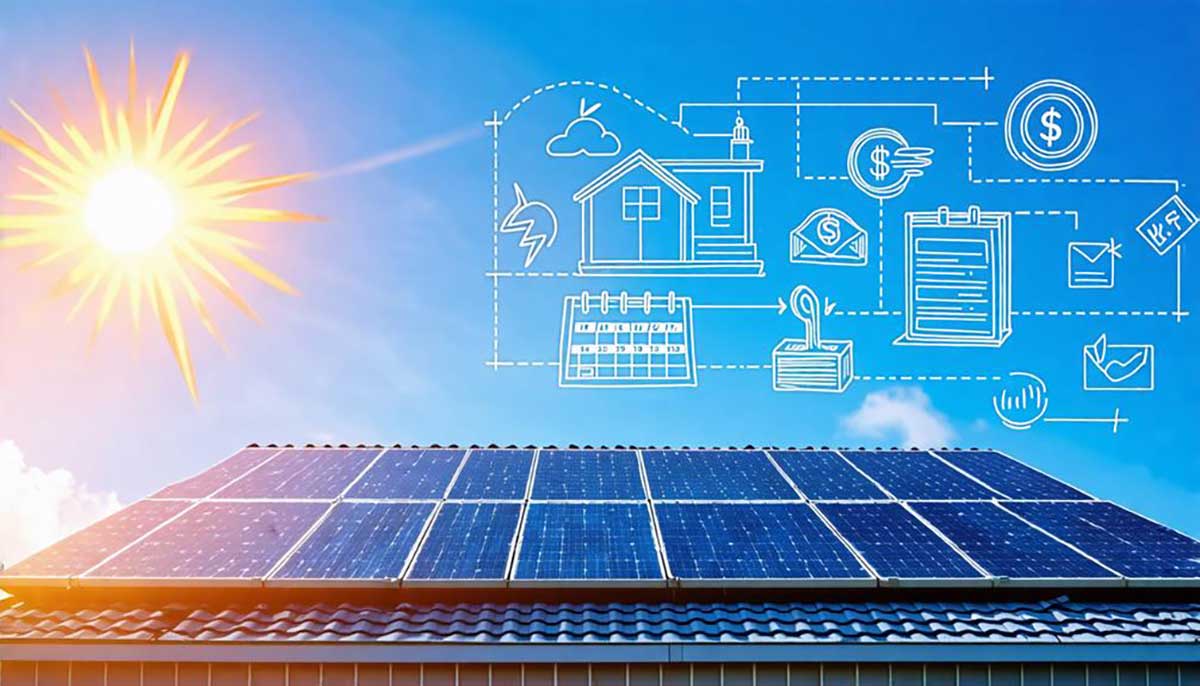Understanding Solar Panel Technology
Delving into solar panel technology reveals a sophisticated system designed to harness the sun’s energy for residential power needs. At the core of this technology are photovoltaic cells, which convert sunlight into electricity through the photovoltaic effect. These cells, arranged in panels, absorb photons and energize electrons, generating direct current (DC) electricity.
To make this power usable in homes, an inverter converts the DC to alternating current (AC). The efficiency of solar panels, typically ranging from 15% to 22%, is an essential factor in their performance. Higher efficiency panels produce more electricity from the same amount of sunlight, making them more effective in limited spaces.
Three main types of solar panels dominate the market: monocrystalline, polycrystalline, and thin-film. Monocrystalline panels offer high efficiency and space-saving benefits, while polycrystalline options provide a cost-effective alternative with slightly lower efficiency. Thin-film panels, known for their flexibility and lightweight properties, generally have lower efficiency rates but offer unique installation possibilities.
The lifespan of solar panels is impressive, averaging 25-30 years. Many manufacturers provide warranties guaranteeing at least 84% of original capacity after 25 years, ensuring long-term value for homeowners investing in this technology.
Financial Considerations and Incentives
While understanding solar panel technology is essential, the financial aspects of residential solar installations often play a decisive role in homeowners’ decision-making processes. The federal solar tax credit significantly reduces upfront expenses, offering a 30% credit on installation costs through 2032. For a $30,000 solar project, this translates to a $9,000 tax credit. Average installation costs for a residential solar system range from $15,000 to $30,000, with a typical 8 kW system costing around $3 per watt in 2022.
Homeowners can expect substantial long-term financial benefits, with annual savings of approximately $1,500 on electricity bills after installing solar panels. Financing options, such as solar loans and Power Purchase Agreements (PPAs), can help spread costs over time, though PPAs may limit access to certain incentives. Net metering policies in many states further improve potential savings by allowing homeowners to receive credits for excess energy produced by their solar systems. When considering the installation of solar panels, it’s vital to evaluate these financial factors alongside technological aspects to make an informed decision that maximizes both environmental and economic benefits.
Installation Process and Requirements

The intricacies of solar panel installation demand careful consideration and professional expertise. While the actual installation process typically spans a few hours, the entire timeline can extend to 2-6 months, primarily due to permitting and inspections. Professional installation is strongly recommended to guarantee proper setup, maintain warranty validity, and secure compliance with local building codes.
Prior to installation, homeowners must assess their roof condition, as any necessary repairs should be completed to avoid additional costs later. Evaluating energy consumption is essential for determining the appropriate system size, with most homes requiring 15-19 solar panels, though this can vary based on individual needs. Local regulations often mandate specific permits for installation, and researching these requirements in advance can streamline the process and prevent delays.
To optimize the installation process, homeowners should engage with experienced professionals who can navigate the complexities of permitting, inspections, and local regulations. This approach not only guarantees technical accuracy but also maximizes the system’s efficiency and longevity. By addressing these key factors, homeowners can facilitate a smooth transition to solar energy while minimizing potential complications and unexpected expenses.
Roof Suitability Assessment
A comprehensive roof suitability assessment is essential before installing solar panels, beginning with a thorough structural integrity check to guarantee the roof can support the additional weight. The roof’s orientation and exposure to sunlight must be evaluated, with south-facing surfaces and minimal shading offering ideal conditions for solar energy production. Additionally, maintenance accessibility considerations should be addressed, including the placement of panels to allow for future repairs and the preservation of proper drainage systems to prevent water-related issues.
Structural Integrity Check
Initiating a solar panel installation journey necessitates a thorough structural integrity check of your roof. This essential step involves evaluating the roof’s age, condition, and load-bearing capacity to guarantee it can support the additional weight of solar panels. Consulting a structural engineer is important to analyze the roof’s strength and determine if reinforcement is required prior to installation.
The roof’s size, orientation, and slope play significant roles in maximizing energy output. South-facing roofs typically offer ideal sun exposure, enhancing solar panel efficiency. However, potential obstructions such as trees or nearby structures must be considered, as they can impede sunlight and reduce energy production.
Proper drainage solutions are critical to prevent water pooling and potential leaks. Making sure that gutters and downspouts remain unobstructed during and after installation is essential for maintaining roof integrity. The roof’s shape and any existing features should be analyzed to confirm they do not interfere with panel placement or compromise the system’s effectiveness.
Orientation and Exposure
Building upon the structural assessment, determining ideal roof orientation and exposure forms a cornerstone of successful solar panel installation. South-facing roofs typically provide optimal sun exposure, maximizing energy production. However, east and west-facing roofs can also be effective, albeit with slightly reduced efficiency. The ideal roof slope for solar panels ranges between 30 and 45 degrees, enhancing sunlight capture throughout the year.
| Orientation | Efficiency | Ideal Slope |
|---|---|---|
| South | Highest | 30-45° |
| East | Good | 30-45° |
| West | Good | 30-45° |
| North | Lowest | 30-45° |
| Flat | Moderate | Adjustable |
Assessing potential shading from nearby obstructions is vital, as even partial shading can significantly decrease solar panel efficiency. Roof condition is just as important; older roofs may require replacement before installation to guarantee longevity and structural integrity. Conducting a home energy audit helps determine the appropriate number of panels needed by analyzing current energy consumption and identifying potential efficiency upgrades. By carefully considering these factors, homeowners can enhance their solar panel system’s performance and maximize long-term energy savings.
Maintenance Accessibility Considerations
Proper maintenance accessibility is an essential factor in analyzing roof suitability for solar panel installation. When evaluating a roof for solar panel placement, homeowners must consider the ease of access for regular inspections, cleaning, and potential repairs. Unobstructed pathways to the panels are necessary for efficient maintenance routines, guaranteeing optimal energy production throughout the system’s lifespan.
Before installation, a thorough roof condition analysis is vital. This evaluation should determine if the existing structure can support the additional weight of solar panels. For older roofs or those with questionable integrity, consulting a structural engineer is advisable to verify the roof’s load-bearing capacity. Additionally, the roof’s size, orientation, and slope play significant roles in maximizing solar exposure and energy output. South-facing roofs generally provide ideal conditions for solar panel efficiency.
Potential shading from nearby structures or vegetation must be carefully considered, as obstructions can significantly reduce the panels’ performance. By addressing these maintenance accessibility considerations and conducting a comprehensive roof suitability analysis, homeowners can guarantee their solar panel investment yields maximum benefits while minimizing future complications and maintenance challenges.
Energy Consumption Analysis
Conducting a comprehensive energy consumption analysis is essential for determining the ideal solar panel system for your home. Begin by evaluating your current power usage through a detailed home energy audit and examination of past electricity bills, which will reveal consumption patterns and potential areas for improvement. To accurately calculate future energy needs, consider seasonal variations in usage, planned energy efficiency upgrades, and any anticipated changes in household consumption, ensuring your solar installation is adequately sized for both present and future requirements.
Assess Current Power Usage
An energy consumption analysis forms the foundation of any successful residential solar panel installation. Conducting a comprehensive home energy audit provides essential insights into your household’s total energy consumption, enabling accurate sizing of your solar panel system. With the average U.S. household consuming approximately 877 kWh per month, understanding your specific monthly usage is vital for an effective solar installation.
To assess your current power usage, track your electricity bills over the past year. This practice reveals seasonal consumption patterns, guiding your decision on the number of solar panels required. Additionally, identifying peak energy usage times helps optimize solar panel output and storage options, guaranteeing efficient energy needs fulfillment.
When sizing your solar system, aim to produce enough energy to cover 80-100% of your monthly needs, factoring in potential future consumption increases. This approach maximizes savings and guarantees long-term sustainability. By thoroughly analyzing your energy consumption patterns, you can make informed decisions about your solar panel system’s size and configuration, ultimately leading to a more effective and cost-efficient residential solar installation tailored to your specific energy requirements.
Calculate Future Energy Needs
Future-proofing your solar installation requires a thorough calculation of anticipated energy needs. Conducting a comprehensive home energy audit is the first step in this process, as it helps identify your average monthly electricity usage. This information is essential for determining the appropriate size of your solar panel system. Analyzing past energy bills provides insights into seasonal variations and peak usage times, ensuring your solar system can accommodate fluctuations in consumption.
When calculating future energy needs, consider potential lifestyle changes that may impact electricity demand, such as adding electric vehicles or expanding your home. Utilize online calculators or consult with solar professionals to estimate the number of solar panels required based on your energy consumption and local sunlight availability. Factor in your area’s net metering policies, as they affect how much excess energy you can sell back to the grid, influencing overall energy needs and potential savings.
Maintenance and Longevity Expectations
Solar panels consistently offer impressive longevity and minimal maintenance requirements, making them an attractive option for homeowners seeking sustainable energy solutions. With warranties typically lasting 25 years and a useful life often extending to 30 years or more, these systems provide long-term value. Maintenance primarily involves regular cleaning to remove debris and guarantee peak performance, contributing to their low-cost upkeep.
Efficiency degradation is a natural occurrence in solar panels, but manufacturers generally guarantee less than 2% loss in the first year and approximately 84% output after 25 years. This gradual decline underscores the importance of regular performance monitoring to identify potential issues early and maximize energy production.
While environmental factors can impact solar panel efficiency, the average cost of maintenance remains low compared to the savings generated. This financial viability, coupled with their longevity, makes solar panels an attractive investment for homeowners. By understanding these maintenance and longevity expectations, individuals can make informed decisions about incorporating solar energy into their residential power solutions, guaranteeing peak performance and return on investment over the system’s lifespan.
Comparing Solar Panel Options
When selecting residential solar panels, homeowners face an important decision that can significantly impact their long-term energy production and cost savings. The three main types of solar panels—monocrystalline, polycrystalline, and thin-film—each offer distinct advantages and trade-offs.
Monocrystalline panels boast the highest efficiency rates (15-22%) and space efficiency, making them ideal for limited roof areas. With a lifespan of 25-30 years, they outperform other options in longevity. Polycrystalline panels, while slightly less efficient, offer a more affordable alternative with a marginally shorter lifespan. Thin-film panels provide flexibility and lightweight installation but typically have lower efficiency rates.
Installation costs vary significantly, with an average of $3 per watt in 2022. An 8 kW system can range from $15,000 to $30,000, depending on panel type and installation specifics. When comparing options, it’s vital to evaluate efficiency degradation over time. High-quality panels are expected to maintain at least 84% of their original capacity after 25 years. Local climate and sunlight exposure play pivotal roles in determining overall energy production, emphasizing the importance of tailoring panel selection to specific geographic conditions.
Frequently Asked Questions
What Do I Wish I Knew Before Buying Solar Panels?
Before investing in solar panels, it’s essential to understand the comprehensive aspects of the decision. Key considerations include accurate cost savings projections, the intricacies of the installation process, and the system’s long-term energy efficiency. Evaluating the environmental impact, available government incentives, and necessary maintenance tips are of equal significance. Additionally, researching warranty options, panel types, financing alternatives, and ideal system sizing can significantly improve the value of your investment, ensuring a more informed and satisfactory solar adoption experience.
What Factors to Consider When Choosing Solar Panels?
Imagine starting a solar journey, where each decision shapes your energy future. When choosing solar panels, consider solar panel types, inverter options, and efficiency ratings to maximize energy output. Evaluate installation costs, warranty terms, and maintenance requirements to guarantee long-term viability. Assess roof compatibility and government incentives to enhance your investment. Factor in environmental impact to align with sustainability goals. A thorough analysis of these elements will illuminate the path to a superior solar solution for your unique needs.
How to Select a Solar Panel for a Home?
Selecting a solar panel for your home requires careful consideration of multiple factors. Evaluate solar panel efficiency to maximize energy production. Assess installation costs and financing options to guarantee affordability. Review warranty options and brand reputation for long-term reliability. Consider your energy needs and roof compatibility for ideal system design. Understand maintenance requirements and local regulations to guarantee compliance. Finally, weigh the environmental impact to align with your sustainability goals. A comprehensive analysis of these factors will guide you towards the most suitable solar panel solution.
How Do I Choose the Right Solar System?
Ah, choosing the right solar system—because who doesn’t want to feel like a modern-day Copernicus? To start this sun-powered odyssey, consider solar panel types, system size, and roof suitability. Plunge into the installation process, financing options, and local regulations. Optimize energy efficiency while minimizing environmental impact. Don’t forget maintenance requirements and warranty details. With meticulous analysis and a penchant for photovoltaic prowess, you’ll soon be basking in the glow of your perfectly tailored solar system.

